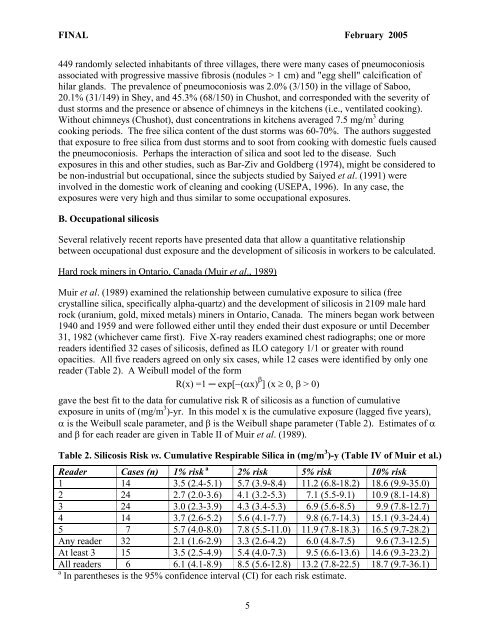Silica (crystalline, respirable) - OEHHA
Silica (crystalline, respirable) - OEHHA
Silica (crystalline, respirable) - OEHHA
You also want an ePaper? Increase the reach of your titles
YUMPU automatically turns print PDFs into web optimized ePapers that Google loves.
FINAL February 2005<br />
449 randomly selected inhabitants of three villages, there were many cases of pneumoconiosis<br />
associated with progressive massive fibrosis (nodules > 1 cm) and "egg shell" calcification of<br />
hilar glands. The prevalence of pneumoconiosis was 2.0% (3/150) in the village of Saboo,<br />
20.1% (31/149) in Shey, and 45.3% (68/150) in Chushot, and corresponded with the severity of<br />
dust storms and the presence or absence of chimneys in the kitchens (i.e., ventilated cooking).<br />
Without chimneys (Chushot), dust concentrations in kitchens averaged 7.5 mg/m 3 during<br />
cooking periods. The free silica content of the dust storms was 60-70%. The authors suggested<br />
that exposure to free silica from dust storms and to soot from cooking with domestic fuels caused<br />
the pneumoconiosis. Perhaps the interaction of silica and soot led to the disease. Such<br />
exposures in this and other studies, such as Bar-Ziv and Goldberg (1974), might be considered to<br />
be non-industrial but occupational, since the subjects studied by Saiyed et al. (1991) were<br />
involved in the domestic work of cleaning and cooking (USEPA, 1996). In any case, the<br />
exposures were very high and thus similar to some occupational exposures.<br />
B. Occupational silicosis<br />
Several relatively recent reports have presented data that allow a quantitative relationship<br />
between occupational dust exposure and the development of silicosis in workers to be calculated.<br />
Hard rock miners in Ontario, Canada (Muir et al., 1989)<br />
Muir et al. (1989) examined the relationship between cumulative exposure to silica (free<br />
<strong>crystalline</strong> silica, specifically alpha-quartz) and the development of silicosis in 2109 male hard<br />
rock (uranium, gold, mixed metals) miners in Ontario, Canada. The miners began work between<br />
1940 and 1959 and were followed either until they ended their dust exposure or until December<br />
31, 1982 (whichever came first). Five X-ray readers examined chest radiographs; one or more<br />
readers identified 32 cases of silicosis, defined as ILO category 1/1 or greater with round<br />
opacities. All five readers agreed on only six cases, while 12 cases were identified by only one<br />
reader (Table 2). A Weibull model of the form<br />
R(x) =1 ─ exp[−(αx) β ] (x ≥ 0, β > 0)<br />
gave the best fit to the data for cumulative risk R of silicosis as a function of cumulative<br />
exposure in units of (mg/m 3 )-yr. In this model x is the cumulative exposure (lagged five years),<br />
α is the Weibull scale parameter, and β is the Weibull shape parameter (Table 2). Estimates of α<br />
and β for each reader are given in Table II of Muir et al. (1989).<br />
Table 2. Silicosis Risk vs. Cumulative Respirable <strong>Silica</strong> in (mg/m 3 )-y (Table IV of Muir et al.)<br />
Reader Cases (n) 1% risk a<br />
2% risk 5% risk 10% risk<br />
1 14 3.5 (2.4-5.1) 5.7 (3.9-8.4) 11.2 (6.8-18.2) 18.6 (9.9-35.0)<br />
2 24 2.7 (2.0-3.6) 4.1 (3.2-5.3) 7.1 (5.5-9.1) 10.9 (8.1-14.8)<br />
3 24 3.0 (2.3-3.9) 4.3 (3.4-5.3) 6.9 (5.6-8.5) 9.9 (7.8-12.7)<br />
4 14 3.7 (2.6-5.2) 5.6 (4.1-7.7) 9.8 (6.7-14.3) 15.1 (9.3-24.4)<br />
5 7 5.7 (4.0-8.0) 7.8 (5.5-11.0) 11.9 (7.8-18.3) 16.5 (9.7-28.2)<br />
Any reader 32 2.1 (1.6-2.9) 3.3 (2.6-4.2) 6.0 (4.8-7.5) 9.6 (7.3-12.5)<br />
At least 3 15 3.5 (2.5-4.9) 5.4 (4.0-7.3) 9.5 (6.6-13.6) 14.6 (9.3-23.2)<br />
All readers 6 6.1 (4.1-8.9) 8.5 (5.6-12.8) 13.2 (7.8-22.5) 18.7 (9.7-36.1)<br />
a<br />
In parentheses is the 95% confidence interval (CI) for each risk estimate.<br />
5















